This post may contain affiliate links. Please read our disclosure policy.
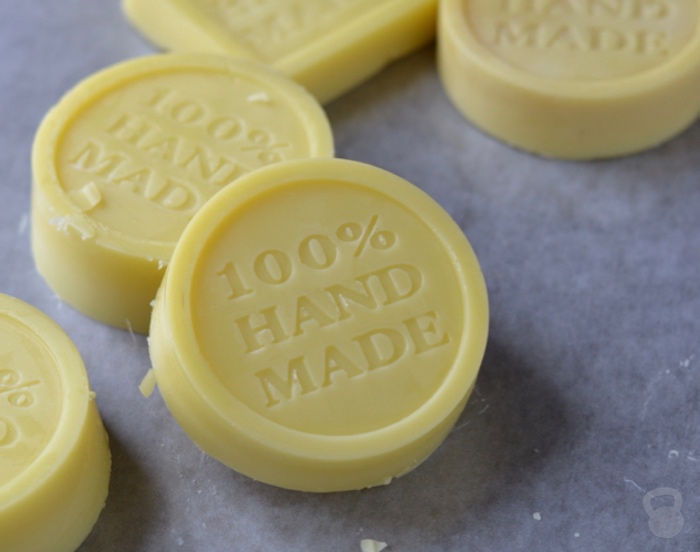
Homemade lotion bars have quickly become one of my favorite natural skin care products to make. This is because it’s really easy to make lotion bars, and the end result is an all-over moisturizer that is incredibly nourishing for the skin.
If you’re new to homemade lotion bars or haven’t personally tried them on your skin yet, you’re in for a treat. Lotions bars are similar to chapstick in that they are solid at room temperature, but soften up and become smooth once applied to skin.
To use, you’ll simply take the homemade lotion bar in your hand, and rub back and forth on your skin until enough moisturizer is applied. Afterwards, you can massage the moisturizer into your skin as needed.
Lotion bars are shelf-stable, so you can store them around the house in small tin containers. I typically keep one at my desk, in my nightstand, and I take one with me in my purse.
And the best part? Lotion bars are great for both dry skin during winter months, and sun-kissed skin during the summer. I find it most useful for problem areas like the elbows, feet, and hands.
Lavender Orange Lotion Bars
Ingredients
1/4 cup coconut oil
1/4 cup jojoba oil
1/2 cup shea butter or cocoa butter
1/2 cup beeswax pellets
20-30 drops sweet orange oil
20-30 drops lavender oil
Directions
Put 1-2 inches of water in a small pot, and place over medium-high heat. Put a glass bowl on top of the pan so that the water is just underneath the bowl, but not touching it. Put all the ingredients for the lotion bars except the essential oils in the glass bowl, and let the ingredients fully melt to combine. You’ll need to stir the mixture occasionally.
Once ingredients have melted, turn off the heat and remove the glass bowl from the pot. Let ingredients cool for about 5 minutes. Once ingredients have cooled, add essential oils, and pour mixture into silicone molds. I use these super cute “100% Handmade” silicone molds.
Let molds sit undisturbed for about 30-45 minutes for lotion bars to set. If you’re short on time, you can throw the lotion bars into fridge to speed up the process.
Remove lotion bars from molds by carefully pealing back the mold. The lotion bar will be hard, but will have a silky texture. This is why I prefer using individual silicone molds that are easy to remove.
Homemade lotion bars are shelf-stable, so you can store them in small tin containers around the house. I typically keep one at my desk, in my nightstand, and I take one with me in my purse.
Tips and Tricks
The basic recipe for homemade lotion bars is 33% oil of choice, 33% butter of choice, 33% beeswax, and 1% essential oil. This means, you can actually experiment with different oils or butters—especially if you know something works well for your skin. I personally love to include coconut oil because of its antimicrobial properties, and jojoba oil for its emollient effects. Sometimes, when I don’t have jojoba oil on hand, I simply use coconut oil for the oil in the recipe, or use olive oil or avocado oil instead.
Keep in mind, when you do try other oils or butters, it will affect the consistency of the bar, and the feeling it has as a moisturizer. I personally like a softer “silkiness,” which is why I use the homemade lotion bar recipe listed above.
Got any questions about making lotion bars, or this homemade lotion bar recipe? Ask in the comments below!
Live empowered,
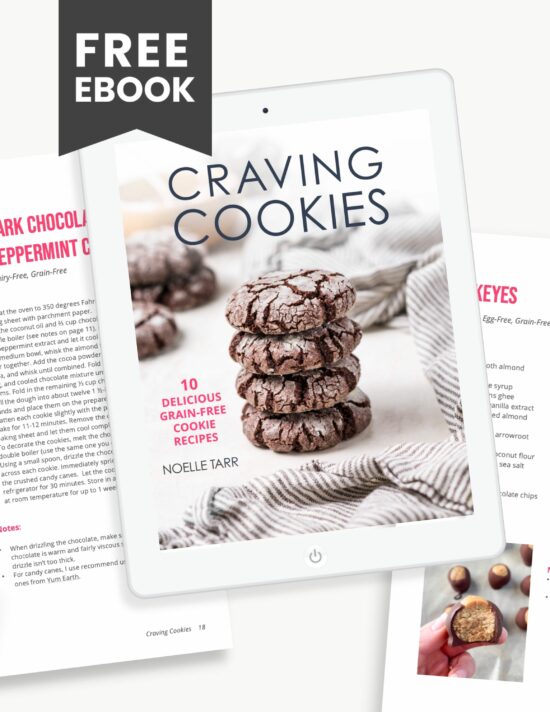
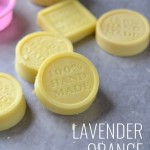
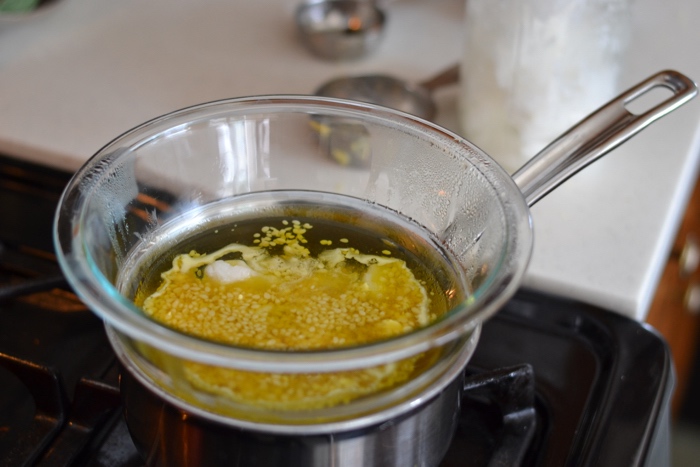
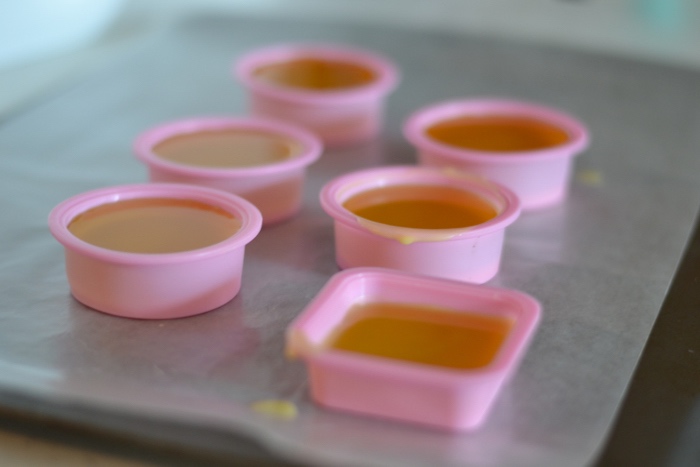
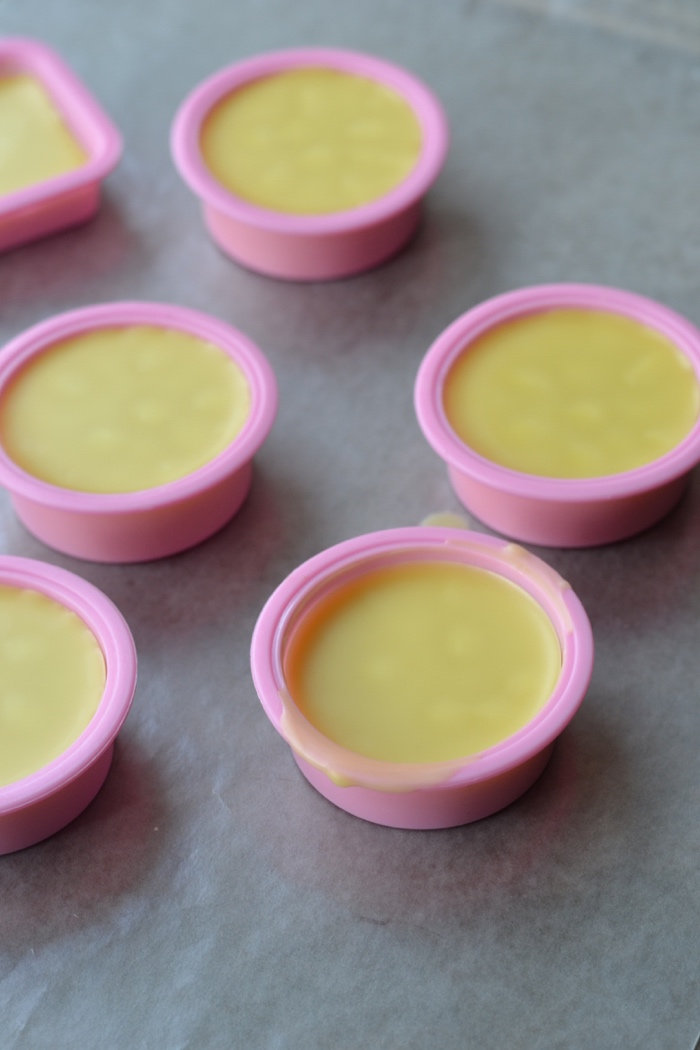
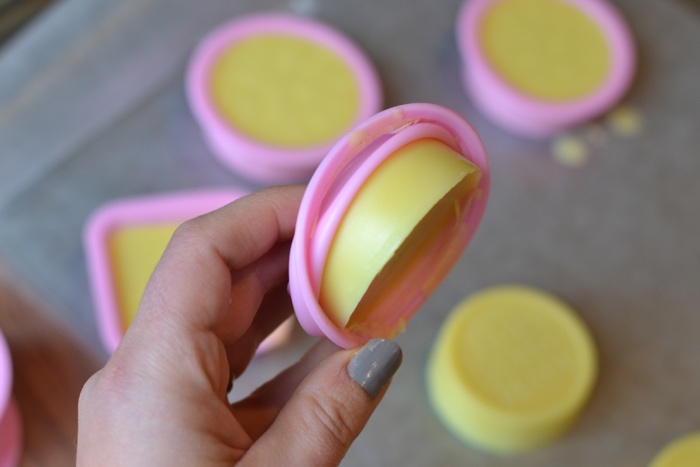
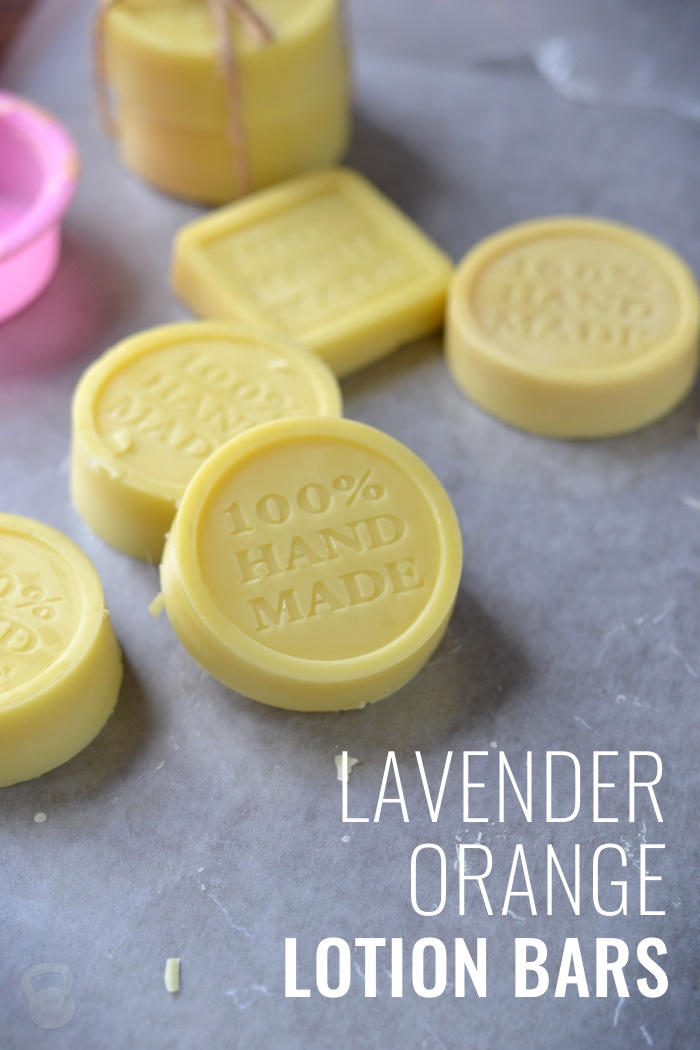

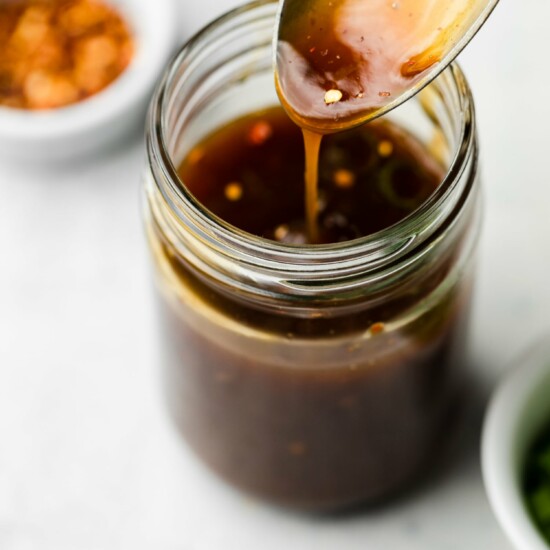

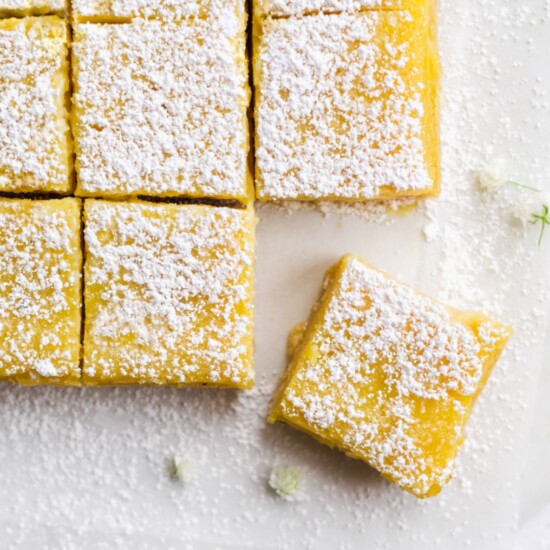
Beth Martin says
This look great, Noelle – can’t wait to try it! And both of the oils you suggest are safe for the 6+ month crowd. I’m thinking this might be a much easier way to get lotion on the baby during the winter.
Noelle says
Ohhh I love that idea, Beth! Let me know how it goes. 🙂
Adrianna says
You can always do 5 drops of each too to be safe for babies. I love these recipes , they’re great!!!
Stacie, RDN | Simply Nourished says
Oooooo lotion bars! I definitely have to give this a try! I have almost all of the ingredients too. Thanks Noelle!
Lana says
How many does this recipe make?
Noelle says
It varies as it all depends on the molds you use.
Emily says
I love this, and all your diy skin care ideas! I just made a batch and was wondering about using it on my dogs’ paws as a moisturizer… what do you think? Have you tried this?
Noelle says
I think it’s a great option! 🙂 Just be careful with what essential oils you use.
Dana says
If you do this, DON’T use cocoa butter. Also research ALL your other ingredients first. For example, if your question had been about a cat, I’d have said *don’t* follow the suggestion to try avocado oil. Avo and cats don’t mix.
Annelies says
Thanks for this recipe! I made a lotion with just coconut oil, Shea butter, and essential oils. I found it a little greasy. Does adding the beeswax make it less greasy? Thanks!
Noelle says
Hi Annelies! Yes, the beeswax adds a bit of hardness to it. Without it, you’ll just have the oil and butter. You can also use mango butter, which is slightly more “smooth” feeling. As for your second question about the mason jar—No. A 4 oz mason jar is only 1/2 cup. These ingredients add up to more than that (1.5 cups).
Annelies says
Sorry one more question 🙂 Would the lotion bars made in the silicon round and square molds that you use fit into a 4oz round mason jar?
Carol says
Does anyone no how many you get out of one recipe
Noelle says
Hi Carol! All depends on your molds. You’ll get 1.5 cups of liquid total. For me, this ended up being about 7-8 bars.
Lulu Mercado says
This is so cool! I will definitely make the same for me and for My daughter! But how can i make
the printed logo or label on top? Thanks!
Noelle says
Hi Lulu! That was made using these soap molds. Good luck!
Beth says
Can? you use sweet almond oil instead of jojoba oil?
Noelle says
Absolutely!
Alice says
hey does the jojoba oil count as an essential oil?
Noelle says
Jojoba oil is not an essential oil. An essential oil is a liquid that is generally distilled (most frequently by steam or water) from the leaves, stems, flowers, bark, roots, or other elements of a plant. They are used for aromatherapy, scenting DIY skin care items, etc.
Suzen says
love this lotion bar recipe makes my winter skin smooth and healty, thank you for sharing it! I just made a batch with chamomile and vanilla oils.
debbie Bowers says
great idea. where did you purchase the stamp 100% hand made
Noelle says
Hi Debbie! On amazon. It’s linked above in the blog post! 🙂
Val says
I don’t really like Coconut Oil as it seems to dry out my skin. Do you think the consistency of the bar would be stable if I substitute sunflower oil, apricot oil or almond oil?
Noelle says
Hi Val! Unfortunately, I haven’t tried using any of those oils, but I would bet that it would change the consistency. Coconut oil is solid at room temperature, which is what helps these set.
Jane says
where do you get the ingredients?
Noelle says
Linked above! Amazon is great.
Brande says
Hi Noelle! I was wondering if it would be ok to store these in glass instead of tins? Would adding food coloring or maybe the powder to add color to these mess up the consistency? Also, do you have any other essential oil blend ideas for this? I’m so excited to make these for Christmas gifts!
Noelle says
Glass it totally fine! You can try Lavender and a small amount of Cedar… super relaxing! The powder might change the consistency, so I wouldn’t do that. Test a small batch and see how it goes! Good luck!
Kate says
Hi Noelle,
I’m having an “oil party” to introduce some friends to the oil life. This would be a fun make and take. Can it be put directly into small tins to set?
Kate
Noelle says
No they’ll need to set in the molds. Have fun!
Sheila says
I made this recipe today as my first lotion bars, and I love them! Thank you dor the recipe. 🙂
Sheila says
for – ugh, my typo. 🙁
Tawana says
I’m a nurse I wash my hands at least 100 times a day any suggestions on how to make a bar big enough to use all day and if so can they be reused?
Noelle says
These bars last a long long time. You can pour the ingredients into any mold to make it any size.
Tina says
Thanks for the recipe. I cannot wait to try it as I have all the ingredients. However, my ingredients are in block form, not liquid form. Would you just shave the beeswax and Shea butter to get the 1/2 cup? Thanks.
Noelle says
Yes you could do that! 🙂
April says
Can something else be substituted for the jojoba oil?
Noelle says
Sure! You could do a different oil that’s liquid at room temperature. Avocado oil would be a great option!
Joanne says
hi,
wondering where you got the little stamp HANDMADE .
Noelle says
Linked above! 🙂
Kim says
Hello, so far every lotion bar recipe I have seen uses coconut oil. Unfortunately I’m allergic to coconut oil. I have found Shea Olein oil, could I use this instead? Or Olive Oil Pomace. Found these on make your own. buzz
Noelle says
Hi Kim! I haven’t tried any substitutions personally. I use coconut oil because it is solid at room temperature, but melts on the skin, so substitutions may change the consistency of the bars. If you try it and it works, feel free to share!
Diane says
I made this today, and I am a bit confused. Equal parts? I used 2/3 cups shea butter, 2/3 cups bees wax pellets and got less than 1 1/3 cups. So I was unsure
on how much oil to use. Beeswax melts down to less than when measured at room temperature. Please advise. Thanks
Noelle says
Hi Diane! What exactly is your question? I would follow the recipe above as directed if you’re looking for a guaranteed result. If you’re looking to experiment, you’ll likely have to tweak things here or there based on the oil/butter/beeswax you use. If you’re going to experiment, I recommend going by weight, not by measurement. I tweaked things and found oils that would be easy to display in measurements (as shown) and would provide a lotion bar consistency that I liked, but that’s my own personal recipe.
Emily says
Made these this afternoon, they are unreal!
So glad I stumbled upon your recipe.
Thank you for posting
??
Heather says
Would i use double the amount of coconut oil if i don’t have jojoba oil?
Noelle says
No, I don’t recommend that as it will change the consistency. Try avocado oil.
Lynne says
Hi I am from the Uk and looking forward to making these. Would it be possible for you to give me the weight of each item instead of cup size as not sure what size cup or mug you use. Many thanks for your help they sound fabulous
Noelle says
Hi Lynne! I do all of my measurements using standard measuring cups to simplify it, so I don’t have the weight of each oil.
Parisanne Turcotte says
Hi, Lynne! In the US we use Imperial measurements. A cup is equal to 8 ounces. So, a half cup is 4 oz. and two cups is 16 oz. I always remember by the saying “A pint’s a pound the world around!” 16 oz = 1 pound =1 pint. Hope this helps!
Susanne Vinther says
Hi Noelle
Can you recommend an alternative to coconut oil?
I am unfortunately highly allergic, but I really would like to try making these lotion bars.
Thank you
Susanne – Denmark
Noelle says
Unfortunately I don’t in this recipe. I would do some searching in Google for coconut oil free lotion bars and see what comes up.
Rachel Williams says
Several people have asked about a substitute for coconut oil, being either allergic (or like myself, finding it a little dehydrating). Has anyone experimented with pomegranate oil in lotion bars? It doesn’t solidify like coconut oil, but might be used as a sub.
Also, maybe it has already been mentioned, but to a certain point, I think you can add more beeswax to compensate for the lack of a solidifying oil. To just what point is not something I know.
Kanthi says
Hi,
Would they work work when used as in shower lotion bars?
Noelle says
No.
Yvonne says
You have the patience of a saint
Noelle says
LOL! Thank you. I will let my husband know someone thinks so!
Debra says
These sound AMAZING!! So I ordered all my organic ingredients that will arrive today! I can’t wait ?
I picked this recipe first, because they sound like they’ll smell so nice, but secondly, be cause my daughters name is Noelle, and she likes doing crafty things with me, so she’ll be my partner in crime when we cook these up tonight ?
Noelle says
Awesome! I hope it turns out well!
Upapalmtree says
Read all q to avoid dupes. Can you melt the ingredients in a glass measuring cup in the microwave?
Noelle Tarr, NTP, CPT says
I don’t recommend it.
Heather says
I’ve melted in a glass measuring cup in the microwave and haven’t had any issues. I just melt for about 60 seconds and then take it out to stir and put it back in until fully melted. I add the essential oils after the oils have mixed together.
Denise says
I have made lavender oil with grape seed oil. How do you think this would affect the texture if I used that instead of jojoba oil?